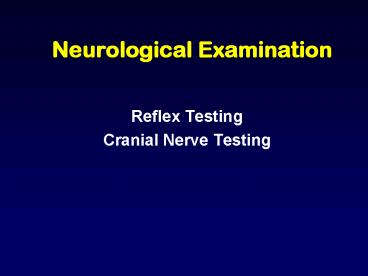Neurological Examination - PowerPoint PPT Presentation
1 / 32
Title:
Neurological Examination
Description:
Patient relaxation and PT too! Necessary for accurate response. Support ... Test one nostril at a time. Eyes closed. Clinical correlation: anosmia. CN II: Optic ... – PowerPoint PPT presentation
Number of Views:186
Avg rating:3.0/5.0
Title: Neurological Examination
1
Neurological Examination
- Reflex Testing
- Cranial Nerve Testing
2
PROCEDURE
- A detailed history of the patient
- focus on present neurologic complaints
- Exam
- Directed by the hypothesis generated by the
subjective history and neurologic signs - The history and exam address 3 questions
- is neurologic pathology present ?
- where is the lesion ?
- what is the nature of the lesion ?
3
Evaluation
- Important to become familiar with what is normal
response - What is normal may vary slightly from patient to
patient - Emphasis today is on screening examination
- Must decide if more thorough evaluation
necessitates referral to specialist
4
Deep Tendon Reflexes
5
Deep Tendon ReflexesMonosynaptic Reflex Arc
6
Reflex Levels
- Biceps
- C5
- Brachioradialis
- C6
- Triceps
- C7
- Patellar
- L4
- Achilles
- S1
7
Biceps C5
8
Brachioradialis C6
9
Triceps C7
10
Patellar or Knee Jerk L4
11
Achilles or Ankle Jerk S1
12
Keys to Success
- Patient relaxation and PT too! ?
- Necessary for accurate response
- Support extremity
- Flick of wrist, not hammering
- Distraction / reinforcement techniques
- Jendrassik Manuever
- UE cross ankles/clench
- LE flexed finger pull
- Document if use
- PRACTICE!
13
Grading
- 0 No response muscle contraction is neither
palpable/visible - 1 Minimal response consisting of slight muscle
contraction without joint movement - 2 Normal response mild muscle contraction
associated with minor joint movement - 3 Brisk response moderate to strong muscle
contraction associated with obvious joint
movement - 4 Hyperactive reflex very strong, brisk muscle
contraction accompanied by exaggerated joint
movement associated with clonus
14
Interpretation
- Grades 0 and 4 are indicative of pathology
- Grade 0 generally LMN involvement or neural
shock during first hours - Grade 4 UMN involvement
- Grades 1 and 3 are normal unless
- Asymmetric
- Associated with other abnormalities
15
Abnormal Results
- Asymmetrical reflexes
- Alterations from proximal to distal
- Peripheral neuropathy
- Pendular reflexes
- Cerebellar disease
16
Upper/Lower Quarter Neurological Screen
17
Pathological Reflexes
- Babinksi
- LE
- Hoffmans
- UE
- Clonus
18
Babinski
- Test run end of reflex hammer up the lateral
aspect of the foot from heel to great toe
19
Positive Babinski
- () DF of great toe with fanning of lesser toes
20
Hoffman Response
- Test Press down on patients middle fingernail
until your fingers flick over the end of
patients nail
() other fingers flex transiently after middle
finger flicked
21
Clonus
- Test quickly stretch foot passively into DF
() test involuntary oscillations or BEATS
between PF/DF
22
Cranial Nerve Testing
23
CN I Olfactory
- Smell
- Use familiar smells
- Test one nostril at a time
- Eyes closed
- Clinical correlation anosmia
24
CN II Optic
- Vision
- Visual acuity
- Peripheral fields
- Bilateral then unilateral
- Allow corrective lenses
- Pupillary light reflex
Clinical correlation blindness
25
CN III Oculomotor
- Pupil dilation
- Pupillary light reflex
- (II III)
- Immediate and simultaneous pupil constriction
- Accommodation reflex
- (II III)
- Focus shift far to near
- Eyes converge, pupils constrict
- Eye movement
Clinical correlation dilated and fixed pupil,
ptosis, ipsilateral gaze fixed down and out
26
CN III, IV VI(Oculomotor, Trochlear, Abducens)
- Eye movement
- Visual tracking
- Follow movement of finger with eyes onlylarge
X - Suspect weakness? unilateral test
Clinical correlation weakness of downward gaze
or lateral gaze
27
CN V Trigeminal
- Muscles of mastigation
- Open/close mouth,
- Bite down
- Palpate masseter
- Facial sensation
- Forehead, cheek, lower jaw light touch
Clinical correlation loss of general sensation,
loss of corneal reflex, deviation of jaw to
ipsilateral side
28
CN VII Facial
- Facial expression,
- Raise eyebrows, smile, show lower teeth, puff out
both cheeks - Taste (ant 2/3)
- Place something salty/sweet on front of tongue
- Clinical correlation flaccid muscles, loss of
blink, loss of taste, Bells palsy
29
CN VIII Vestibulocochlear
- Hearing (Cochlear)
- Gross Hearing Test
- Rub fingers together 12 inches from patients
ear - Detect ability to hear left vs. right
- Tuning fork
- Rinne/Weber Tests
- Balance (Vestibular)
- Balance
- Nystagmus
- Pt looks forward, right, left
- Eyes examined for involuntary oscillations
- Past pointing
- PT finger arms length from pt pt alternately
touch nose and reach toward finger EO/EC
- Clinical correlation deafness, disequilibrium
30
CN IX X
- CN IX Glossopharyngeal
- Taste (posterior 1/3)
- Swallow
- CN X Vagus
- Innervates larynx
- Swallow
- Test
- Gag reflex?
- Swallowing
Clinical correlation loss of gag reflex, loss
of taste, dysphagia, dysarthria
31
CN XI Spinal Accessory
- Trapezius and SCM motor
- Resisted shrug
- Bilaterally
- Unilaterally
- Resisted cervical rotation
Clinical correlation difficulty in turning
head, ipsilateral shoulder drooping
32
CNXII Hypoglossal
- Tongue movement
- Tongue protrusion should occur in midline
- Clinical correlation ipsilateral paralysis of
tongue































